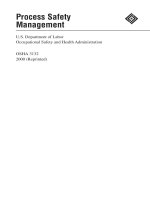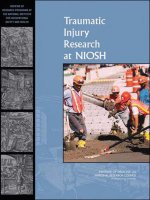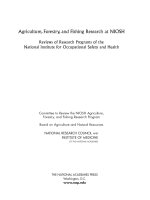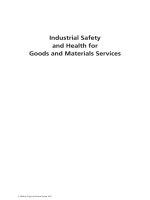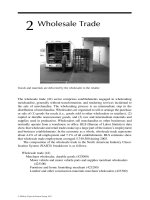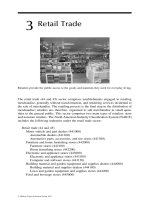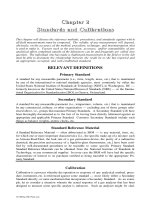Occupational Safety and Health Fundamental Principles and Philosophies - An toàn và sức khỏe nghề nghiệp các nguyên tắc và triết lý cơ bản
Bạn đang xem bản rút gọn của tài liệu. Xem và tải ngay bản đầy đủ của tài liệu tại đây (8.38 MB, 403 trang )
Occupational Safety
and Health
Fundamental Principles and Philosophies
Occupational Safety
and Health
Fundamental Principles and Philosophies
Charles D. Reese
CRC Press
Taylor & Francis Group
6000 Broken Sound Parkway NW, Suite 300
Boca Raton, FL 33487-2742
© 2017 by Taylor & Francis Group, LLC
CRC Press is an imprint of Taylor & Francis Group, an Informa business
No claim to original U.S. Government works
Printed on acid-free paper
International Standard Book Number-13: 978-1-138-74883-5 (Paperback)
International Standard Book Number-13: 978-1-138-03505-8 (Hardback)
This book contains information obtained from authentic and highly regarded sources. Reasonable efforts have been
made to publish reliable data and information, but the author and publisher cannot assume responsibility for the
validity of all materials or the consequences of their use. The authors and publishers have attempted to trace the copyright holders of all material reproduced in this publication and apologize to copyright holders if permission to publish
in this form has not been obtained. If any copyright material has not been acknowledged please write and let us know
so we may rectify in any future reprint.
Except as permitted under U.S. Copyright Law, no part of this book may be reprinted, reproduced, transmitted, or
utilized in any form by any electronic, mechanical, or other means, now known or hereafter invented, including photocopying, microfilming, and recording, or in any information storage or retrieval system, without written permission
from the publishers.
For permission to photocopy or use material electronically from this work, please access www.copyright.com (http://
www.copyright.com/) or contact the Copyright Clearance Center, Inc. (CCC), 222 Rosewood Drive, Danvers, MA
01923, 978-750-8400. CCC is a not-for-profit organization that provides licenses and registration for a variety of users.
For organizations that have been granted a photocopy license by the CCC, a separate system of payment has been
arranged.
Trademark Notice: Product or corporate names may be trademarks or registered trademarks, and are used only for
identification and explanation without intent to infringe.
Library of Congress Cataloging‑in‑Publication Data
Names: Reese, Charles D., author.
Title: Occupational safety and health : fundamental principles and philosophies / Charles D. Reese.
Description: Boca Raton : Taylor & Francis, a CRC title, part of the Taylor & Francis imprint, a
member of the Taylor & Francis Group, the academic division of T&F Informa, plc, 2017. | Includes
bibliographical references.
Identifiers: LCCN 2016052420 | ISBN 9781138035058 (hardback : acid-free paper)
| ISBN 9781315269603 (ebook)
Subjects: LCSH: Industrial safety. | Industrial hygiene.
Classification: LCC T55 .R434 2017 | DDC 363.11--dc23
LC record available at />Visit the Taylor & Francis Web site at
and the CRC Press Web site at
Contents
Preface........................................................................................................................................... xvii
Author............................................................................................................................................ xix
Section A Occupational Safety and Health
1.Introduction..............................................................................................................................3
Why Is Occupational Safety and Health Needed?...............................................................3
The Components of Safety and Health Initiatives...............................................................5
Summary....................................................................................................................................7
Further Readings......................................................................................................................8
2.History.......................................................................................................................................9
Evolution of OSH......................................................................................................................9
Results from History.............................................................................................................. 11
Further Readings.................................................................................................................... 11
3.Hazards.................................................................................................................................... 13
Energy....................................................................................................................................... 14
Further Readings.................................................................................................................... 16
4. Occupational Safety.............................................................................................................. 17
Summary.................................................................................................................................. 19
Further Readings.................................................................................................................... 20
5. Occupational Health............................................................................................................. 21
Health Hazards.......................................................................................................................22
Health Hazard Prevention.................................................................................................... 23
Identifying Health Hazards.................................................................................................. 23
Quick Health Hazard Identification Checklist................................................................... 25
Summary.................................................................................................................................. 26
Further Readings.................................................................................................................... 26
Section B Organizing Safety and Health
6. Manage Occupational Safety and Health......................................................................... 29
Why Management?.................................................................................................................30
Safety and Health (Managing).............................................................................................30
Why Is Managing Safety and Health a Needed Entity?................................................... 32
Summary: Why Management?.............................................................................................34
Further Readings.................................................................................................................... 35
v
vi
Contents
7. Safety and Health Programs............................................................................................... 37
Why Have a Comprehensive Safety and Health Program?............................................. 38
Why Build an Occupational Safety and Health Program?............................................... 39
Components of a Safety and Health Program....................................................................40
Evaluative Questions Regarding Safety and Health Programs....................................... 41
Tools for a Safety and Health Program Assessment.........................................................43
Why Other Required Written Programs?........................................................................... 45
Summary.................................................................................................................................. 46
Further Readings.................................................................................................................... 46
8. Special Emphasis Programs................................................................................................ 49
Summary.................................................................................................................................. 49
Further Readings.................................................................................................................... 50
9. Accident Investigations........................................................................................................ 51
Reporting Accidents............................................................................................................... 53
Summary..................................................................................................................................54
Further Readings.................................................................................................................... 55
10. Training................................................................................................................................... 57
When to Train.......................................................................................................................... 57
Why Train New Employees?................................................................................................. 58
Why Train Supervisors?......................................................................................................... 59
Why Train Employees?........................................................................................................... 60
Why Communications?.......................................................................................................... 61
Why Is Training a Key Element?.......................................................................................... 61
Why OSHA Training?............................................................................................................ 62
Why a Legal Basis for Training?...........................................................................................63
Summary..................................................................................................................................63
Further Readings....................................................................................................................64
Section C Administration
11. Safety and Health Budget.................................................................................................... 67
Health Budgeting.................................................................................................................... 68
Safety Budgeting..................................................................................................................... 69
Management Budgeting......................................................................................................... 69
Environmental Budgeting..................................................................................................... 70
Product Safety Budgeting...................................................................................................... 70
Compliance Factors................................................................................................................ 70
Written Budget........................................................................................................................ 71
Controlling Cost...................................................................................................................... 71
Summary.................................................................................................................................. 72
Further Readings.................................................................................................................... 72
Contents
vii
12. Statistics and Tracking......................................................................................................... 73
Analyzing Incident Data........................................................................................................ 73
OSHA Record Keeping.......................................................................................................... 74
Company Records................................................................................................................... 74
Important Ancillary Data Needed for More Complete Analysis.................................... 75
Safety and Health Statistics Data......................................................................................... 76
Statistical Analysis for Comparisons................................................................................... 76
Workers’ Compensation.........................................................................................................77
Summary..................................................................................................................................77
Further Readings.................................................................................................................... 78
13. Safety and Health Ethics...................................................................................................... 79
Ethics......................................................................................................................................... 79
Occupational Safety and Health Ethics............................................................................... 81
Further Readings.................................................................................................................... 81
14. Employee Involvement.........................................................................................................83
Why Should Employees Be Involved?.................................................................................84
Why Does Management Have to Be Involved?..................................................................84
Why Employee Involvement?................................................................................................ 85
Why Are Employee Outcomes Important?......................................................................... 86
Why Are Goals Needed for Employee Involvement?........................................................ 87
Summary.................................................................................................................................. 87
Further Readings.................................................................................................................... 88
15. Joint Labor/Management Safety and Health Committees............................................ 89
Committee Makeup................................................................................................................90
Record Keeping.......................................................................................................................90
Do’s and Don’ts of L/M Committees.................................................................................... 90
Do’s.......................................................................................................................................90
Don’ts.................................................................................................................................... 91
Expectations............................................................................................................................. 91
Outcomes................................................................................................................................. 92
Joint L/M Occupational Safety and Health Committees.................................................. 92
Summary.................................................................................................................................. 93
Further Readings.................................................................................................................... 94
16. Workplace Inspections......................................................................................................... 95
Need for an Inspection........................................................................................................... 95
When to Inspect?..................................................................................................................... 97
What to Inspect?...................................................................................................................... 97
Types of Inspection Instruments.......................................................................................... 98
Summary.................................................................................................................................. 99
Further Readings.................................................................................................................... 99
viii
Contents
Section D Personnel Involved in Occupational Safety and Health
17. Management’s Commitment and Involvement............................................................. 103
Why Roles and Responsibilities?........................................................................................ 105
Why Management?............................................................................................................... 105
Further Readings.................................................................................................................. 106
18. Line Supervisors.................................................................................................................. 107
Further Readings.................................................................................................................. 108
19. Workers.................................................................................................................................. 109
Why Workers?....................................................................................................................... 109
Further Readings.................................................................................................................. 111
20. Safety Director or Manager............................................................................................... 113
Further Readings.................................................................................................................. 114
21. Safety and Health Professional........................................................................................ 115
Further Readings.................................................................................................................. 118
22. Industrial Hygienist............................................................................................................ 119
Why an Industrial Hygienist?............................................................................................. 119
When an Industrial Hygienist Is Needed......................................................................... 120
Further Readings.................................................................................................................. 121
23. Safety and Health Consultant........................................................................................... 123
Why a Need for a Consultant?............................................................................................ 123
Interviewing a Consultant................................................................................................... 124
Why a Scope of Work?.......................................................................................................... 125
The Hiring Process............................................................................................................... 126
Summary................................................................................................................................ 127
Further Readings.................................................................................................................. 128
Section E People-Related Issues
24. Motivating Safety and Health.......................................................................................... 131
Setting the Stage.................................................................................................................... 132
Defining Motivation............................................................................................................. 133
Principles of Motivation....................................................................................................... 133
The Motivational Environment.......................................................................................... 134
Structuring the Motivational Environment...................................................................... 134
Simplify Motivation.............................................................................................................. 136
The Key Person...................................................................................................................... 137
Summary................................................................................................................................ 138
Further Readings.................................................................................................................. 139
Contents
ix
25. Behavior-Based Safety........................................................................................................ 141
Behavior-Based Safety Today.............................................................................................. 141
BBS Described....................................................................................................................... 142
Hindrances to Implementing BBS...................................................................................... 143
Summary................................................................................................................................ 144
Further Readings.................................................................................................................. 145
26. Safety Culture...................................................................................................................... 147
Defining Safety Culture....................................................................................................... 147
Developing or Changing a Safety Culture........................................................................ 147
Positive Safety Culture......................................................................................................... 149
Assessing Safety Culture..................................................................................................... 150
Summary................................................................................................................................ 150
Further Readings.................................................................................................................. 150
27. Communicating Safety and Health................................................................................. 151
The Communicator............................................................................................................... 152
Communication Tools.......................................................................................................... 153
Written Materials............................................................................................................. 153
Bulletin Boards................................................................................................................. 154
Electronic Signs................................................................................................................ 154
Computers......................................................................................................................... 154
Safety and Health Posters............................................................................................... 154
Public Address System.................................................................................................... 155
Safety Talks....................................................................................................................... 155
Summary................................................................................................................................ 155
Further Readings.................................................................................................................. 155
28. Bullying................................................................................................................................. 157
Data Regarding Bullying..................................................................................................... 158
Facts about Bullying............................................................................................................. 160
Why Bullying Occurs?......................................................................................................... 161
Why Prevention of Bullying?.............................................................................................. 162
Summary................................................................................................................................ 163
Further Readings.................................................................................................................. 163
29. Safety (Toolbox) Talks........................................................................................................ 165
Further Readings.................................................................................................................. 166
30. Incentives/Rewards............................................................................................................. 167
Incentives............................................................................................................................... 167
Incentive Programs............................................................................................................... 168
Summary................................................................................................................................ 169
Further Readings.................................................................................................................. 170
x
Contents
Section F Hazards
31. Hazard Identification.......................................................................................................... 173
Hazard Identification for Protection.................................................................................. 174
Further Readings.................................................................................................................. 175
32. Hazard Analysis.................................................................................................................. 177
Hazards and Risk................................................................................................................. 178
Hazard Analysis................................................................................................................... 178
Further Readings.................................................................................................................. 181
33. Root Cause Analysis........................................................................................................... 183
Summary................................................................................................................................ 184
Further Readings.................................................................................................................. 185
34. Forms of Root Cause Analysis.......................................................................................... 187
Root (Basic) Cause Analysis................................................................................................ 188
Root Cause Analysis Methods............................................................................................ 188
System Safety Engineering.................................................................................................. 189
Further Readings.................................................................................................................. 190
35. Cost......................................................................................................................................... 191
The True Bottom Line.......................................................................................................... 191
Cost of Accidents................................................................................................................... 192
Summary................................................................................................................................ 192
Further Readings.................................................................................................................. 193
Section G Risk
36. Acceptable or Tolerable Risk............................................................................................. 197
Why Can Risk Be Tolerated at an Acceptable Level?....................................................... 197
Further Readings.................................................................................................................. 199
37. Risk Assessment.................................................................................................................. 201
Developing a Risk Assessment........................................................................................... 201
Purpose of Risk Assessment............................................................................................... 202
Explaining the Risk Assessment........................................................................................ 202
Risk Evaluation..................................................................................................................... 202
Summary................................................................................................................................ 203
Further Readings.................................................................................................................. 203
38. Risk Management................................................................................................................ 205
Risk Management Components.......................................................................................... 205
Why Manage Risk?............................................................................................................... 206
Summary................................................................................................................................ 207
Further Readings.................................................................................................................. 207
Contents
xi
Section H Controlling Hazards
39. Designing for Prevention.................................................................................................. 211
Designing for Humans........................................................................................................ 211
Designers’ Responsibility.................................................................................................... 212
Further Readings.................................................................................................................. 212
40. Controls................................................................................................................................. 213
Technical Aspect of Hazard Controls................................................................................ 213
Source Control....................................................................................................................... 214
Control along the Path from the Hazard to the Worker................................................. 214
Barriers.............................................................................................................................. 214
Absorption........................................................................................................................ 214
Dilution.............................................................................................................................. 214
Control at the Level of the Worker..................................................................................... 214
Selecting Controls................................................................................................................. 215
Risk Control........................................................................................................................... 215
Evaluating the Effectiveness of Controls........................................................................... 215
Awareness Devices............................................................................................................... 216
Work Practices....................................................................................................................... 216
Administrative Controls...................................................................................................... 216
Work Procedures, Training, and Supervision.................................................................. 217
Hazard Prevention and Controls....................................................................................... 218
Hazard Control Summary................................................................................................... 218
Summary................................................................................................................................ 218
Further Readings.................................................................................................................. 219
41. Personal Protective Equipment........................................................................................ 221
Why a Hazard Assessment?................................................................................................223
Why Establish a PPE Program?..........................................................................................223
Summary................................................................................................................................ 224
Further Readings..................................................................................................................225
42. Occupational Safety and Health Administration (OSHA)......................................... 227
OSHA Standards................................................................................................................... 228
Protections under the OSHAct........................................................................................... 228
National Institute for Occupational Safety and Health (NIOSH).................................. 228
Occupational Safety and Health Review Commission (OSHRC).................................. 229
Employer Responsibilities under the OSHAct................................................................. 229
Workers’ Rights and Responsibilities under the OSHAct.............................................. 230
Discrimination against Workers......................................................................................... 231
Right to Information............................................................................................................. 231
OSHA Inspections................................................................................................................ 232
Worker Training.................................................................................................................... 232
Occupational Injuries and Illnesses................................................................................... 233
Summary................................................................................................................................ 233
Further Readings..................................................................................................................234
xii
Contents
Section I Accident/Incident Prevention Techniques
43. Safe Operating Procedures................................................................................................ 237
Why Are SOPs Beneficial?................................................................................................... 239
What Are the Components Needed to Develop an SOP?............................................... 239
Why SOPs Are Poorly Written............................................................................................ 240
Why SOPs Work.................................................................................................................... 241
Summary................................................................................................................................ 242
Further Readings.................................................................................................................. 243
4 4. Job Safety Analysis............................................................................................................. 245
Why JSA?................................................................................................................................ 245
Why Perform a JSA/JHA?................................................................................................... 246
Why Four Basic Steps in Developing a JSA/JHA?........................................................... 247
Why Select Jobs by Using Criteria?.................................................................................... 247
Why Identify the Hazards Associated with Each Job Step?........................................... 248
Why Consider Human Problems in the JSA/JHA Process?........................................... 249
Why Must Ways to Eliminate or Control Hazards Be Developed?............................... 249
Why Change Job Procedures?............................................................................................. 249
Why Change the Frequency of Performing a Job?........................................................... 250
Why Consider PPE?.............................................................................................................. 250
Summary................................................................................................................................ 251
Further Readings.................................................................................................................. 251
45. Job Safety Observation...................................................................................................... 253
Why JSO?................................................................................................................................ 253
Why Select a Job or Task for a Planned JSO?....................................................................254
Why Preparing for a JSO Is Necessary?............................................................................ 255
Why a Checklist of Activities to Be Observed Is Needed............................................... 256
Why the Observation?.......................................................................................................... 257
Why Conduct a Postobservation?....................................................................................... 258
Why Deal with Unsafe Behaviors or Poor Performance?............................................... 258
Summary................................................................................................................................ 259
Further Readings.................................................................................................................. 260
46. Fleet Safety........................................................................................................................... 261
Why Have a Fleet Safety Program?.................................................................................... 262
Why Vehicle Maintenance?................................................................................................. 262
Why Is Driver/Operator Selection Important?................................................................. 263
Why and What Records Need to Be Maintained?........................................................... 264
Summary................................................................................................................................ 264
Further Readings.................................................................................................................. 265
47. Preventive Maintenance Programs.................................................................................. 267
Why Specific Components Are Needed for an Effective PMP?..................................... 268
Why Preventive Maintenance?........................................................................................... 268
Why Management’s Role?.................................................................................................... 268
Why a Formalized PMP?..................................................................................................... 269
Contents
xiii
Why the Operator Should Conduct Inspections?............................................................ 269
Why Maintenance?............................................................................................................... 270
Why Management’s Responsibility?.................................................................................. 270
Summary................................................................................................................................ 270
Further Readings.................................................................................................................. 271
Section J Extraneous Hazards
48. Emergency Planning........................................................................................................... 275
Why EAPs?............................................................................................................................. 277
Why Are Certain Elements Required or Recommended?.............................................. 278
Why Preplan?........................................................................................................................ 280
Summary................................................................................................................................ 280
Further Readings.................................................................................................................. 281
49. Workplace Security and Violence.................................................................................... 283
Workplace Violence Statistics.............................................................................................. 283
Risk Factors............................................................................................................................ 285
Prevention Strategies and Security.................................................................................... 285
Environmental Design.................................................................................................... 285
Administrative Controls................................................................................................. 286
Behavioral Strategies....................................................................................................... 286
Perpetrator and Victim Profile............................................................................................ 287
Cost of Violence Is a Reason to Address It........................................................................ 287
Prevention Efforts................................................................................................................. 287
Why Program Development and Essential Elements?.................................................... 288
Types of Workplace Violence and Events.......................................................................... 289
Type I Events..................................................................................................................... 289
Type II Events................................................................................................................... 289
Type III Events.................................................................................................................. 290
Why Address Workplace Violence?................................................................................... 290
Summary................................................................................................................................ 291
Further Readings.................................................................................................................. 291
50. External Force: Terrorism................................................................................................... 293
Travel Security....................................................................................................................... 294
Hardening Facilities Increases Protection........................................................................ 294
Potential Terrorist’s Weapons.............................................................................................. 295
Protection from Chemical, Biological, or Radiological Attacks..................................... 295
Summary................................................................................................................................ 296
Further Readings.................................................................................................................. 296
51. Off-the-Job Safety............................................................................................................... 299
Further Readings..................................................................................................................300
xiv
Contents
Section K Miscellaneous Safety and Health Factors
52. Human Factors..................................................................................................................... 303
Defining Human Factors..................................................................................................... 303
Human Factor Safety............................................................................................................ 303
Human Characteristics........................................................................................................304
Why Human Causal Factors?..............................................................................................304
Benefits of Using Human Factors.......................................................................................304
Summary................................................................................................................................305
Further Readings..................................................................................................................305
53. Ergonomics............................................................................................................................ 307
Force........................................................................................................................................ 307
Repetition...............................................................................................................................308
Awkward Postures...............................................................................................................308
Static Postures.......................................................................................................................308
Vibration.................................................................................................................................308
Contact Stress........................................................................................................................ 309
Cold Temperatures...............................................................................................................309
Extent of the Problem........................................................................................................... 310
Developing an Ergonomic Program.................................................................................. 310
Physical Work Activities and Conditions.......................................................................... 311
Limits of Exposure................................................................................................................ 311
Ergonomic Controls.............................................................................................................. 311
Identifying Controls............................................................................................................. 312
Assessing Controls............................................................................................................... 312
Implementing Controls........................................................................................................ 313
Tracking Progress................................................................................................................. 313
Proactive Ergonomics........................................................................................................... 314
Further Readings.................................................................................................................. 315
5 4. Product Safety...................................................................................................................... 317
Why a Safe Design Approach Should Be Employed....................................................... 317
Principles of Safe Design..................................................................................................... 317
Legal Obligations.................................................................................................................. 318
Consultation.......................................................................................................................... 318
When Developing a Safe Design Action Plan.................................................................. 318
What Is Consumer Product Safety Screening?................................................................. 318
Why Are Products Screened for Safety?........................................................................... 319
How Is Safety Screening Done?.......................................................................................... 319
Labeling—What Does It All Mean?................................................................................... 319
Summary................................................................................................................................ 319
Further Readings.................................................................................................................. 320
Contents
xv
Section L Safe Facilities and Handling
55. Fire Prevention and Life Safety........................................................................................ 323
Why Address Fire Hazards?............................................................................................... 323
Causes of Fires....................................................................................................................... 323
What the Occupational Safety and Health Administration Standards Require......... 324
Avoiding Fires....................................................................................................................... 325
Fire Safety and Protection................................................................................................... 326
Fire Prevention...................................................................................................................... 326
Managing Fire Safety........................................................................................................... 327
The Importance of Fire Safety and Life Safety Design................................................... 328
FPP Requirements................................................................................................................ 329
Fire Protection Summary.................................................................................................... 330
Further Readings.................................................................................................................. 333
56. Hazardous Materials........................................................................................................... 335
Why Hazmats Need Special Handling............................................................................. 336
Transportation of Hazmats................................................................................................. 336
Storage and Packing........................................................................................................ 337
Transporting..................................................................................................................... 337
Regulations and Hazmats................................................................................................... 337
Hazardous Waste.................................................................................................................. 338
US Hazardous Waste............................................................................................................ 339
Final Disposal of HW........................................................................................................... 339
Recycling...........................................................................................................................340
Portland Cement..............................................................................................................340
Incineration, Destruction, and Waste-to-Energy.........................................................340
HW Landfill (Sequestering, Isolation, Etc.)..................................................................340
Summary................................................................................................................................ 341
Further Readings.................................................................................................................. 341
57. Transportation......................................................................................................................343
Employer’s Responsibility...................................................................................................343
Transporting Materials........................................................................................................343
Employees of Transportation Businesses..........................................................................344
Summary................................................................................................................................344
Further Readings..................................................................................................................345
Section M Meshing Safety with Management Approaches
58. Process Safety Management.............................................................................................. 349
Process Development........................................................................................................... 349
Process Hazard Analysis..................................................................................................... 350
Operating Procedures.......................................................................................................... 351
Safe Work Practices............................................................................................................... 352
Employee Participation........................................................................................................ 352
xvi
Contents
Training.................................................................................................................................. 352
Initial Training................................................................................................................. 352
Refresher Training........................................................................................................... 353
Training Documentation................................................................................................. 353
Contractors............................................................................................................................. 353
Application........................................................................................................................ 353
Employer Responsibilities.............................................................................................. 353
Contract Employer Responsibilities...................................................................................354
Pre-Start-Up Safety Review.................................................................................................354
Mechanical Integrity............................................................................................................ 355
Hot Work Permit................................................................................................................... 355
Management of Change....................................................................................................... 356
Incident Investigation........................................................................................................... 356
Emergency Planning and Response.................................................................................. 357
Compliance Audits............................................................................................................... 357
Trade Secrets.......................................................................................................................... 357
OSHA’s Response.................................................................................................................. 358
Summary................................................................................................................................ 358
Further Readings.................................................................................................................. 359
59. Total Quality Management............................................................................................... 361
Development of TQM in the United States....................................................................... 362
Features of TQM................................................................................................................... 362
Definition............................................................................................................................... 363
Principles of TQM.................................................................................................................364
TQM Implementation Approaches..................................................................................... 365
Safety and Health Integrated into TQM............................................................................ 365
The Concept of Continuous Improvement by TQM........................................................ 366
Steps in Managing the Transition...................................................................................... 366
Summary................................................................................................................................ 367
Further Readings.................................................................................................................. 368
60. Lean Safety........................................................................................................................... 369
New Approaches: Lean Safety and Sustainability.......................................................... 369
Benefits of Lean Safety......................................................................................................... 369
Challenges of Lean Safety................................................................................................... 370
Changing Culture................................................................................................................. 370
Learning and Training......................................................................................................... 371
Sustainability......................................................................................................................... 371
Summary................................................................................................................................ 372
Further Readings.................................................................................................................. 373
Index.............................................................................................................................................. 375
Preface
Most occupational safety and health (OSH) books tell the reader how to apply all the concepts, principles, elements, and tools of prevention and develop interventions and initiatives to mitigate occupational injuries, illnesses, and deaths.
This book is not a how-to book. It is a book that addresses the principles and philosophical basis for all the varied components and elements needed to develop and manage an
effective safety and health program or initiative. It is a book designed to answer the questions often posed as to why should we do it this way. It is the why book.
This book was developed to provide safety professionals, students, and employers with
the basic tenets for the justification and purpose of an OSH initiative and for those responsible for safety and health within the industrial and business communities.
Those involved with assuring that a safe and healthy workplace is provided to employees are always challenged as to why principle and philosophical approaches are needed
in order to develop and implement a functional OSH environment. Those responsible for
safety and health are always answering the following questions, Why do we need this
component or these elements? Can their use be justified as to effectiveness and cost? How
will it work? How sure are you of your recommendation(s)?
The intent of this book is to provide a reference, blueprint, and a helpmate for the philosophical basis and the use of the principles for inclusion in OSH and the justification for
their inclusion as integral components of doing business.
Suffice it to say that the protection of an employer’s workforce should be the primary
goal or objective of any OSH initiative.
This book includes the philosophical aspects of organizing safety and health in a corporation, company, or organization; the impacts that people have on safety and health;
the tools available for application of safety and health issues; and the potential for new or
evolving approaches in addressing workplace safety and health.
A philosophical approach and use of principles expresses the reasons and logic that dictate the decision-making process regarding what methodology, elements, and applications
to use that have been successfully and effectively implemented during the past 46 years
since the inception of the Occupational Safety and Health Administration to facilitate the
protection of the United States’ workforce.
Thus, Occupational Safety and Health: Fundamental Principles and Philosophies addresses the
issue of why we address OSH issues in a structured and organized fashion in the same
manner as we would use for any other facet of a business.
xvii
Author
Dr. Charles D. Reese, for 37 years has been involved with OSH as an educator, manager,
or consultant. In Dr. Reese’s early beginnings in OSH, he held the position of industrial
hygienist at the National Mine Health and Safety Academy. He later assumed the responsibility of manager for the nation’s occupational trauma research initiative at the National
Institute for Occupational Safety and Health’s (NIOSH) Division of Safety Research.
Dr. Reese has played an integral part in trying to ensure that workplace safety and health
is provided for all those within the workplace. As the managing director for the Laborers’
Health and Safety Fund of North America, his responsibilities were aimed at protecting
the 650,000 members of the laborers’ union in the United States and Canada.
He has developed many OSH training programs, which run the gamut from radioactive
waste remediation to confined-space entry. Dr. Reese has written numerous articles, pamphlets, and books on related safety and health issues.
Dr. Reese, professor emeritus, was a member of the graduate and undergraduate faculty
at the University of Connecticut, where he taught courses on Occupational Safety and
Health Administration (OSHA) regulations, safety and health management, accident prevention techniques, industrial hygiene, ergonomics, and environmental trends and issues.
As professor of environmental/OSH, he coordinated the bulk of the environmental, safety,
and health efforts at the University of Connecticut. He is called upon to consult with
industry on safety and health issues and is often asked for expert consultation in legal
cases.
Dr. Reese also is the principal author of the following:
Handbook of OSHA Construction Safety and Health (Second Edition)
Material Handling Systems: Designing for Safety and Health
Annotated Dictionary of Construction Safety and Health
Occupational Health and Safety Management: A Practical Approach (Third Edition)
Office Building Safety and Health
Accident/Incident Prevention Techniques (Second Edition)
The four-volume set entitled Handbook of Safety and Health for the Service Industry:
Volume 1: Industrial Safety and Health for Goods and Materials Services
Volume 2: Industrial Safety and Health for Infrastructure Services
Volume 3: Industrial Safety and Health for Administrative Services
Volume 4: Industrial Safety and Health for People Oriented Services
xix
Section A
Occupational Safety and Health
For an extended period of time, occupational safety and health (OSH) has been viewed
as a separate discipline, but its credibility has been enhanced by the Occupational Safety
and Health Act of 1970. The intent of this discipline is centered upon providing America’s
workforce a safe and healthy workplace free from hazards. This section is intent upon
providing a background upon which safety and health can be folded in as an integral part
of the business model.
The contents of this section are as follows:
Chapter 1—Introduction
Chapter 2—History
Chapter 3—Hazards
Chapter 4—Occupational Safety
Chapter 5—Occupational Health
1
Introduction
In order to understand why occupational safety and health (OSH) is an area of concern
and relevant to the operation of a business or industry, the why is best explained by becoming familiar with why so much emphasis is placed on the development of OSH as a critical
part of the business environment.
Why businesses address OSH is as important as how they achieve an effective safety
and health effort. Every business must have a reason to address OSH as well as why each
component or element of the safety and health initiative or program is undertaken.
Why Is Occupational Safety and Health Needed?
Usually, consequences of not addressing safety and health have to do with why OSH is
addressed by employers. These consequences include but are not limited to the following:
•
•
•
•
•
•
•
•
•
•
Injury or illness to members of the workforce
Loss of profit
Loss of credibility as a responsible company
Liability of not addressing safety and health
Loss of productivity
Loss of employees due to danger, risk, injury, illness, death, or unsafe/unhealthy
work environment
Decrease of employee morale
Damage to or loss of capital investment (e.g., equipment or facilities)
Decrease in reputation and integrity of the company
View that the company does not exhibit good business practices
Many why questions can be posed regarding the need for OSH, such as the following:
•
•
•
•
•
•
•
Why address OSH?
Why develop an OSH program?
Why is involvement crucial?
Why is behavior important?
Why is action required?
Why are the varied components and elements of the OSH initiative undertaken?
Why are accidents and incidents tracked?
3
4
Occupational Safety and Health
•
•
•
•
•
•
Why are occupational illnesses tracked?
Why are hazards identified?
Why are interventions and controls utilized?
Why is training and education a part of OSH?
Why is management of OSH important?
Why are the Occupational Safety and Health Administration’s regulations an
important component?
• Why is a safe and healthy workplace important?
• Why are safety and health incentives as important as rewards and bonuses for
production?
• Why is communications important for achieving OSH?
This is the first book that sets forth the principles and philosophies for OSH. In the past,
most books have always undertaken to provide the tools that would help all those practitioners of OSH to develop the needed policies, procedures, and programs that are used to
develop and implement an effective safety and health initiative for any type of company
or organization. These have been primarily how-to books. Within this book, Occupational
Safety and Health: Fundamental Principles and Philosophies, we discuss the foundational basis
that motivates employers to protect their employees from injuries and illnesses caused by
exposures in the workplace.
Philosophy is a critical study of the basic principles and concepts of a particular branch
of knowledge—that being OSH for this book—as an integral part of conducting business
while assuring that an understanding of those principles and concepts is being applied
in a manner that provides a safe and healthy workplace for the workforce. This book provides the philosophical basis for application of management principles to OSH as well as
the implications of culture to OSH. A short history is provided in Chapter 2 to demonstrate
why OSH has become an area of workplace interest. This may help put things in perspective related to the evolution of OSH as it is known today.
The Healthy People 2010 objectives from the US Department of Health and Human
Services (DHHS) has made the facts available relevant to occupational injuries and illnesses. Every 5 seconds, a worker is injured. Every 10 seconds, a worker is temporarily
or permanently disabled. Each day, an average of 137 persons die from work-related diseases, and an additional 17 die from workplace trauma injuries on the job. Each year, about
70 youths under 18 years of age die from injuries at work, and 70,000 require treatment in
a hospital emergency room. In 2015, the US Bureau of Labor Statistics estimated that the
American workforce suffered from 2.9 million work-related injuries and illnesses, onehalf of which were disabling in nature (about 1.5 million). This equates to an average of in
excess of 5,900 injuries per workday. All of these statistics equate to a cost. Professor J. Paul
Leigh of the University of California at Davis has seen an escalation of cost since 1992 in
the amount of $33 billion. The new estimation of the cost to businesses in the United States
has been estimated to have reached over $250 billion in 2012 for a 1-year period.
No matter the numbers, it demonstrates that workplace carnage is endemic and, some
might say, of epidemic proportions.
A number of data systems and estimates exist to describe the nature and magnitude of
occupational injuries and illnesses, all of which have advantages as well as limitations. In
1996, information from death certificates and other administrative records indicated that
at least 6,112 workers died from work-related injuries. No national occupational chronic
